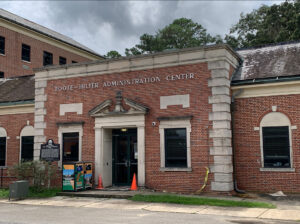
The Foote Hilyer administration building has endured several major changes and renovations during the past 110 years.
In the early 1900s, FAMU President Nathan Young, wanted to have a nurse training facility on campus. Construction began in 1909 and by 1911 it opened as a wooden, two-story, 19-bed building to train nursing students as well as a center to treat tuberculosis patients. Jennie Virginia Hilyer, a registered nurse at the hospital, supervised the facility.
In 1926, the facility was unofficially known as the School of Nursing and upgraded to a 100-bed capacity.
Twenty years later, under then-President William Gray and Dr. Leonard H.B. Foote, it became FAMC Hospital, Health Center and Nursing Center. By 1950, FAMU and garnered more than $2 million and continued to be a fully operational hospital.
During segregation, the hospital was the only medical facility within a 150-mile radius of Tallahassee to serve and treat Blacks. However, in 1971 the hospital closed after Tallahassee Memorial was integrated and federal funding stopped for FAMU’s hospital.
At that point it was converted to house many student services including Student Health Services, Financial Aid, among others. Additionally, the legacy of the hospital led to the establishment of Florida A&M University’s College of Pharmacy and the School of Allied Health Services.
Fast-forward 50 years and Foote-Hilyer is now beginning to feel somewhat vacant after the new Center for Access and Student Success building opened in January of this year.
“Mainly all of the student services departments used to be spread out across campus, so they wanted to make it convenient for [students] to have it in one centralized location,” said Miriam Franklin, program assistant for university housing.
Students no longer have too many reasons to visit Foote-Hilyer besides the Rattlers’ Nest eatery. At Foote-Hilyer, several business administrative offices remain, such as: Human Resources, Comptroller, Institutional Research, Equal Opportunity programs, Assessment, Audit, Compliance, General Counsel, Research and Budget.
Students have been saying they like the convenience of having the CASS building serve as home to so many student services.
“It has been closer in the center of campus instead of having to walk down the hill to Foote Hilyer … it seems a bit more organized as well, so I really enjoy that,” said Takayla Perry, a fourth-year economics major.
Joshua Oliver, a third-year biology pre-med student, echoed that observation. “It’s like a one-stop shop, everything from admissions to housing is all right there. The building is definitely helpful as opposed to walking or driving and trying to find parking,” he said.